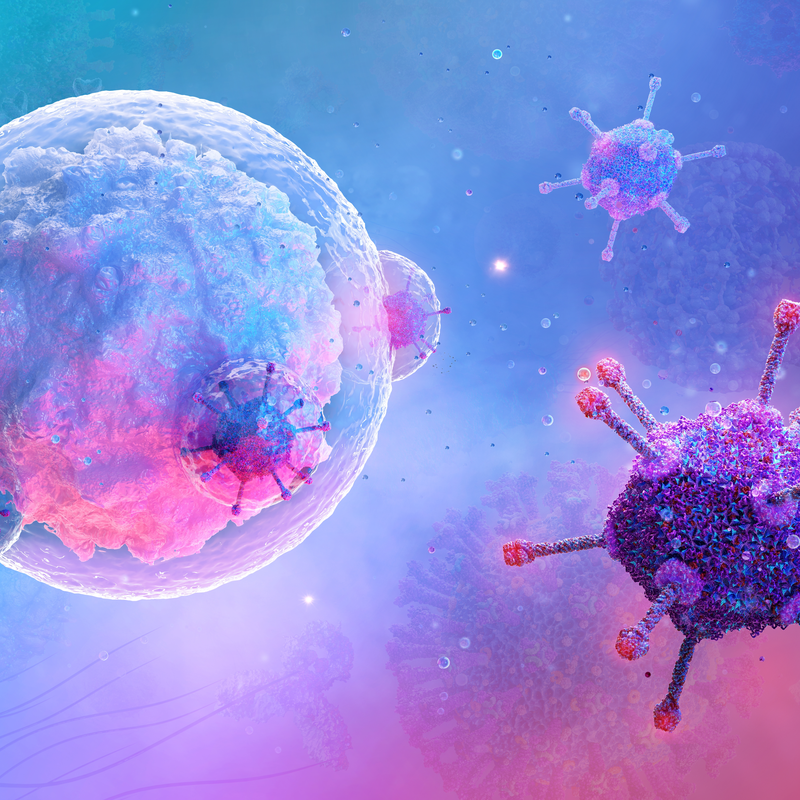
What is Waldenström's macroglobulinemia?
A Waldenström's macroglobulinaemia or Waldenström's disease is a indolent non-Hodgkin's lymphoma characterised by monoclonal proliferation of a single mutant B cell. These cell clones produce large amounts of immunoglobulin M and infiltrate the bone marrow. The disease was named after the Swedish internist and first describer Dr. Jan Gösta Waldenström.
How common is Waldenström's macroglobulinemia?
This is quite a rare disease, accounting for only about 1 to 3 % of all non-Hodgkin's lymphomas. The average age at diagnosis is about 75 years. Only rarely does the disease occur in people under 40 years of age. Across Europe, the annual incidence is about 4 to 7 new cases per 1 million inhabitants. Men and Caucasians are more likely to be affected.
What are the symptoms of Waldenström's macroglobulinemia?
The most common symptoms include fatigue and non-specific B symptoms such as night sweats, weight loss and fever. In most patients, the first clues come from a randomly performed routine blood count. This shows a normocytic, normochromic anaemia and, in rarer cases, thrombocytopenia or neutropenia . The bone marrow infiltration rarely causes perceptible pain . The infiltration of other organs, on the other hand, can manifest itself as palpable and visible splenomegaly, lymphadenopathy or hepatomegaly. Only in very few cases does very large lymph node conglomerations occur, as in Hodgkin's lymphoma.
Mostly a hyperviscosity syndrome is only noticeable from an IgM level of more than 5 g /dl. This leads to an increased risk of thromboembolism and at the same time to an increased tendency to bleed. Other complications that can occur are:
- Cardiac symptoms such as angina pectoris,
- Neurological symptoms such as dizziness, vigilance disorders and ataxia,
- Visual disturbances up to and including loss of vision,
- Hearing problems.
'In
about 20 % of those affected, the monoclonal IgM behaves like a
cryoglobulin type1. However, the symptoms are found in less than 5 % of
patients. Above all, Raynaud's syndrome is typical here.
In slightly less than 3 % of those affected, a light-chain amyloidosis develops with a variety of symptoms such as exertional dyspnoea, nephrotic syndrome and sensorimotor polyneuropathy.
How is Waldenström's macroglobulinemia diagnosed?
If Waldenström's disease is suspected, the first step is to have the blood tested by haematologist. If this shows that the concentration of the antibody immunoglobulin M is elevated, the bone marrow of the patient is examined with the help of a bone marrow puncture.
A medical history can also provide initial indications of Waldenström's disease. Especially if the patient reports complaints such as epistaxis, fatigue, dizziness, transient paresis, headache and B symptoms.
A thorough physical examination may reveal signs of organ infiltration, such as hepatomegaly, splenomegaly or lymphadenopathy. Ophthalmological changes can also be detected with the help of an examination.
The CT imaging method is used to determine the extent of organ infiltration. In particular, lung filtrates, hepatosplenomegaly and intestinal lymph nodes are examined.
How is Waldenström's macroglobulinemia treated?
The disease does not always need immediate therapeutic treatment. The disease progresses quite slowly, so it is often possible to wait and monitor patients closely. Affected persons are then treated when a lack of blood cells, nerve disorders and a restriction of the quality of life become apparent. In most cases, the therapy is then carried out with the help of chemotherapy, which is combined with immunotherapy. Patients who suffer a relapse or cannot receive immunochemotherapy have other targeted treatment measures available. If amyloidosis occurs in a patient, it is usually treated with bortezomib-based therapy, with or without high-dose therapy, with stem cell transplantation or therapy with rituximab.
How is Waldenström's macroglobulinemia followed up?
In addition to the medical history and the thoroughly performed physical examination , the laboratory parameters are also determined closely and at regular intervals during ongoing therapy. These include the differential blood count as well as LDH, liver function parameters and kidney function parameters. After approximately half of the cycles and after completion of therapy, but also if progression is suspected , imaging procedures are performed to evaluate therapy. Follow-up is then carried out at intervals of 3 months, and from the third year the intervals increase to 6 and then 12 months.
What is the prognosis for Waldenström's macroglobulinemia?
In recent years, the prognosis has improved continuously. The 5-year survival rate is now estimated at approximately 80 %. The following have been summarised as the most important risk factors:
- Age of 65 years and older,
- Haemoglobin below 11.5 g/dl,
- Platelet count below 100,000 per ul,
- ß2-microglobulin above 3 mg/l,
- IgM over 70 g/dl.
Is a cure for Waldenstrom's macroglobulinemia possible?
The disease is chronic and still cannot be cured. However, most of those affected can live for many years without symptoms with treatment. For very many patients, treatment over a longer period is not necessary.
Is Waldenström's macroglobulinemia hereditary?
Until today, the causes of Waldenström's macroglobulinemia are still completely unclear. Although the cells of the tumour show a change in the genetic material, it is not possible to say what triggers this . A familial cluster was found in one fifth of those affected. Therefore, although it can be assumed that Waldenström's macroglobulinemia is hereditary or hereditary, this has not been medically proven.
